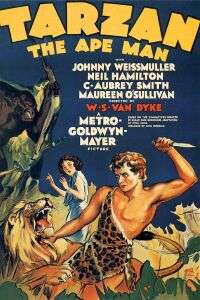Tarzan the Ape Man (1932 film)
Tarzan the Ape Man is a 1932 pre-Code American action adventure film released by Metro-Goldwyn-Mayer featuring Edgar Rice Burroughs' famous jungle hero Tarzan and starring Johnny Weissmuller, Neil Hamilton, C. Aubrey Smith and Maureen O'Sullivan. It was Weissmuller's first of 12 Tarzan films. O'Sullivan played Jane in six features between 1932 and 1942.[2] The film is loosely based on Burroughs' 1912 novel Tarzan of the Apes, with the dialogue written by Ivor Novello. The film was directed by W. S. Van Dyke. Metro-Goldwyn-Mayer released two remakes of Tarzan, the Ape Man in 1959 and in 1981, but each was a different adaptation of Rice Burroughs' novel.
| Tarzan the Ape Man | |
|---|---|
 Theatrical poster | |
| Directed by | W. S. Van Dyke |
| Produced by | Irving Thalberg |
| Written by | Cyril Hume |
| Based on | Tarzan of the Apes 1912 magazine by Edgar Rice Burroughs |
| Starring | Johnny Weissmuller Neil Hamilton Maureen O'Sullivan C. Aubrey Smith |
| Music by | George Richelarie |
| Cinematography | Clyde De Vinna |
| Edited by | Tom Held Ben Lewis |
Production company | |
| Distributed by | Loew's Inc. |
Release date |
|
Running time | 99 minutes |
| Country | United States |
| Language | English |
| Budget | $652,675 |
| Box office | $2.8 million (worldwide rental)[1] |
Plot
James Parker (C. Aubrey Smith) and Harry Holt (Neil Hamilton) travel in Africa on a quest for the legendary elephant burial grounds and their ivory. They are joined by Parker's daughter Jane (Maureen O'Sullivan). Holt is attracted to Jane, and tries somewhat ineffectively to protect her from the jungle's dangers. He notably fails to prevent her abduction by the jungle's guardian, the mysterious Tarzan (Johnny Weissmuller) and his ape allies.
The experience is terrifying to Jane at first, but as their relationship develops, she finds herself happy: "Not a bit afraid, not a bit sorry." As she returns to her father, her feelings are brought to a test. She wants Tarzan to come with her to London, and to be part of her world. But Tarzan turns his back on her and returns to the jungle. Her father tells her that is where Tarzan belongs, she cries, "No dad, he belongs to me."
The expedition is captured by a tribe of aggressive dwarfs. Jane sends Tarzan's ape friend Cheeta (Jiggs) for help, bringing Tarzan to their rescue. During the rescue, Tarzan summons elephants and they escape from the dwarf's stronghold, although Jane's father dies from wounds just as they reach the elephant graveyard. Jane decides to stay in the jungle with Tarzan and in the final scene, to the music of Tchaikovsky's Romeo and Juliet, the happy couple appear on a rock, Jane holding Cheeta like a baby.
Cast
- Neil Hamilton as Harry Holt
- Maureen O'Sullivan as Jane Parker
- C. Aubrey Smith as James Parker
- Doris Lloyd as Mrs Cutten
- Forrester Harvey as Beamish
- Ivory Williams as Riano
- Johnny Weissmuller as Tarzan
- Ray Corrigan as Ape
- Johnny Eck as Bird Creature
Production
The film was shot on Lot One of the Metro-Goldwyn-Mayer studios in Culver City, California and at the Lake Sherwood area north of Los Angeles[3] as well as Silver Springs in Florida. Lions from the film were borrowed from nearby Goebel's Lion Farm in Thousand Oaks, CA. Goebel himself would often camp by the filming site near Lake Sherwood to watch his lions during filming.[4]
As with most Weissmuller Tarzan films, the elephants were Indian, which have smaller ears, rather than African, so large fake ears, and fake tusks, were fitted onto the animals in an attempt to make them look authentic.[5] Similarly, the tribe of African dwarfs, made to look like pygmies (all males), portrayed in the film was actually a cast of several white midgets wearing blackface.[5]
Stock footage made in Africa for W.S. Van Dyke's Trader Horn was added to location work shot in the then-undeveloped Toluca Lake region north of Los Angeles.[6]
Release
The film was released on April 4, 1932.
Reception
The film was MGM's biggest film of the season with a worldwide rental of $2,540,000. A subsequent re-release earned an additional $225,000.[1]
Film review aggregator Rotten Tomatoes reported an approval rating of 100%, based on 13 reviews, with a rating average of 7.8/10.[7]
References
- The Eddie Mannix Ledger, Los Angeles, California: Margaret Herrick Library, Center for Motion Picture Study.
- https://www.imdb.com/search/title?title_type=feature,tv_episode,video,tv_movie,tv_special,tv_miniseries,documentary,video_game,short&roles=nm0919321,nm0001577&sort=year,asc
- George E. Turner, ed. The Cinema of Adventure, Romance, & Terror. ASC Cinema Press, 1988.
- Maulhardt, Jeffrey Wayne (2011). Jungleland. Arcadia Publishing. Page 7. ISBN 9780738574448.
- Ethington, Phillip J. (2008). "Global Spaces of Los Angeles". In Prakash, Gyan; Kruse, Kevin Michael (eds.). The Spaces of the Modern City: Imaginaries, Politics, and Everyday Life. Princeton University Press. p. 88. ISBN 978-0-691-13343-0.
- Miller, Frank, Tarzan, the Ape Man (1932), tcm.com
- "Tarzan the Ape Man (1932) - Rotten Tomatoes". Rotten Tomatoes.com. Rotten Tomatoes. Retrieved 14 November 2016.
- DVD commentary for the Tarzan Collection DVD set released in 2005.
External links
| Wikimedia Commons has media related to Tarzan the Ape Man (1932 film). |
| Wikiquote has quotations related to: Tarzan the Ape Man (1932 film) |
- Tarzan the Ape Man on IMDb

- Tarzan the Ape Man at AllMovie

- Tarzan the Ape Man at the TCM Movie Database

- Tarzan the Ape Man at the American Film Institute Catalog

- Tarzan the Ape Man at FilmSite.org
- Tarzan the Ape Man history at ERBzine.com
- A film clip Tarzan the Ape Man trailer is available at the Internet Archive